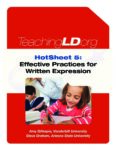Effective Practices for Written Expression
Writing is a complex task that involves the use and coordination of many cognitive processes. Because of its complexities, many students, including students with disabilities, often find writing tasks challenging. Proficiency in writing skills is important for success in and out of the classroom (e.g., college, work, daily life). Therefore, it is important to identify writing instruction and classroom practices shown to be effective in scientific studies of writing interventions. In this HotSheet, we (a) define written expression, (b) explain why written expression is important, (c) provide important basic facts about written expression, and then (d) summarize more and less effective practices for providing students instruction in writing.
What is Written Expression?
Written expression serves a variety of purposes. In school, students are typically expected to use writing to help them learn new information (e.g., note-taking, summarizing), to communicate their knowledge and understanding (e.g., short-answer test questions, open-ended essay responses), and to express themselves (e.g., journaling, poetry). To write, students must perform many mental operations, including (a) understanding the writing topic, (b) recalling topic knowledge to address the writing topic, (c) setting goals for writing and developing writing plans to meet these goals, and (d) using writing process knowledge to put thoughts and ideas into written form. Many factors, such as a student’s skills in self-monitoring and self-regulation or a student’s beliefs about his or her own abilities as a writer, influence how well he or she is able to balance the multiple cognitive demands and processes involved in writing. Additionally, other writing-related skills, such as handwriting and spelling skills, also affect a student’s ability to express thoughts and ideas in written form effectively.
Why is Written Expression Important?
Effective written communication is important for success in school. Written products are a primary means by which teachers measure students’ knowledge, understanding, and progress. Furthermore, writing is a powerful tool for learning. As students write, they reflect and think critically about new information, which permits them to construct new and deeper understandings of subject matter. Writing also provides a means for students’ self-expression. Beyond the school setting, writing is a primary means of communication in daily life (e.g., emailing a friend or coworker, composing a grocery list, text messaging). Effective written expression is also important for success in post-secondary education and the workforce. Employers report that writing is increasingly valued in some form (e.g., emails, memos, presentations) for a number of occupations. Also, written expression skills are taken into consideration when hiring and promoting salaried employees.
Written Expression Facts
- Writing is an active and multifaceted process, involving the simultaneous use of cognitive processes (e.g., planning and organizing ideas) and writing skills (e.g., handwriting or spelling).
- Many students with disabilities can generate great ideas for writing, but their weaknesses in transcription (i.e., handwriting, typing, spelling) impede them from getting their thoughts onto paper.
- Strategies for improving students’ written expression skills can be taught.
- Teachers should instruct students in how to monitor and reinforce their own behavior throughout the writing process.
- For struggling writers and students with disabilities to become proficient writers, additional time, individualized instruction, and explicit instruction in transcription skills (i.e., handwriting, spelling, typing) is often necessary.
- With any combination of writing instructional procedures a teacher chooses to use, students must be given ample time to write.
Written Expression
 View PDF: "Written Expression"
View PDF: "Written Expression" Amy Gillespie and Steve Graham provide facts about writing and describe less/more effective practices.